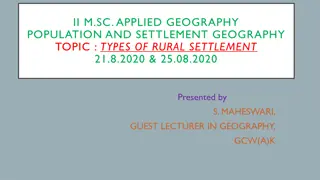Geometrical Patterns in Rural Settlements: Shapes and Designs
The geographical shape of a rural settlement plays a significant role in determining its pattern. Various shapes such as rectangular, linear, star-shaped, T-shaped, and more are formed based on the site characteristics and cultural factors. Different settlement designs like compact or dispersed are also influenced by physical and social factors. Examples of these settlements can be found in various regions around the world.
Download Presentation

Please find below an Image/Link to download the presentation.
The content on the website is provided AS IS for your information and personal use only. It may not be sold, licensed, or shared on other websites without obtaining consent from the author.If you encounter any issues during the download, it is possible that the publisher has removed the file from their server.
You are allowed to download the files provided on this website for personal or commercial use, subject to the condition that they are used lawfully. All files are the property of their respective owners.
The content on the website is provided AS IS for your information and personal use only. It may not be sold, licensed, or shared on other websites without obtaining consent from the author.
E N D
Presentation Transcript
The shape of a rural settlement have a geometrical connotation. The geographical shape of a settlement is determined by characteristics of the settlement site. It is also a function of the cultural factors but in the absence of other factors the geographical shape of the site determines the pattern or shape of the settlement. So the term form is used to describe the pattern of shape of a settlement.
Rectangular shaped Linear shaped Star shaped T shaped, Y shaped, L shaped pattern Circular and semi circular Pattern Triangular shaped pattern Nebular Pattern Fan pattern settlement Hollow square pattern village Hollow rectangular pattern settlement Chessboard pattern settlement Fortified pattern settlement
Rectangular pattern is mainly found in the productive alluvial plains and wide inter montane valleys. The lanes in the rectangular pattern settlement almost straight, meeting each other at right angles. Such settlements are typically developed by farming communities. Examples : Rural settlements of the Sutlage ganga plains, germany, russia, Chaina etc.
o Most important design of settlement o In this settlement houses are arranged along the side of roads, railway tracts, rivers or canals, edge of the valleys in hilly or mountainous region, or above the flood level zone along the coastline. o Either this design of settlement takes a compactness because of small distance between the houses or it make dispersed settlement when the gap between the house became large. o Most of this settlement design is determined by the physical and social factors. o Examples: Middle Himalayas, Alps, Hindukush etc.
The star like settlements develop on the sites and places where several metalled or unlevelled roads converge. In this design houses are spread out along the sides of the roads in all direction. This type of settlements is common in both towns and villages and is caused by new development spreading out the major roads. It is the converted form of circular settlement. Examples: North west Europe, Punjab province of Pakistan.
These types of shapes are simply modification of linear settlements. T or L shaped settlements develop at the junction point of two roads meet at 90 degree angle. While, Y shaped settlement develops at the junction point of three roads at wide angles. Then the houses also take the shape of English alphabet Y . In such cases, Two or three lines of houses will meet at the point where the roads of communication meet.
The circular or semi circular settlements are develop along the river side or Ox-bow lakes or coastal areas. Generally physical factors are responsible for this design. Security needs often lead to circular shape of settlements . Most of the settlements are associated with forts are circular. Occasionally depends on sours of resources like water resource, may also lead to growth of circular settlements . A pond or well in a desert work like wet point may lead to a circular shape of the settlements. In the other hand fisherman and salt producers develop their settlements along the sea coasts and salt lakes respectively. Such settlements acquire the circular or semi circular shapes.























